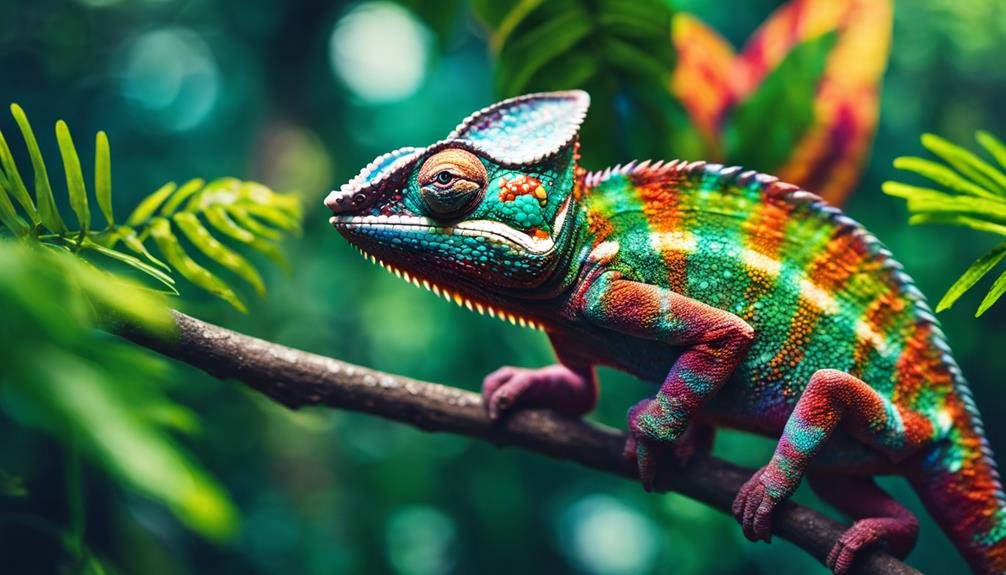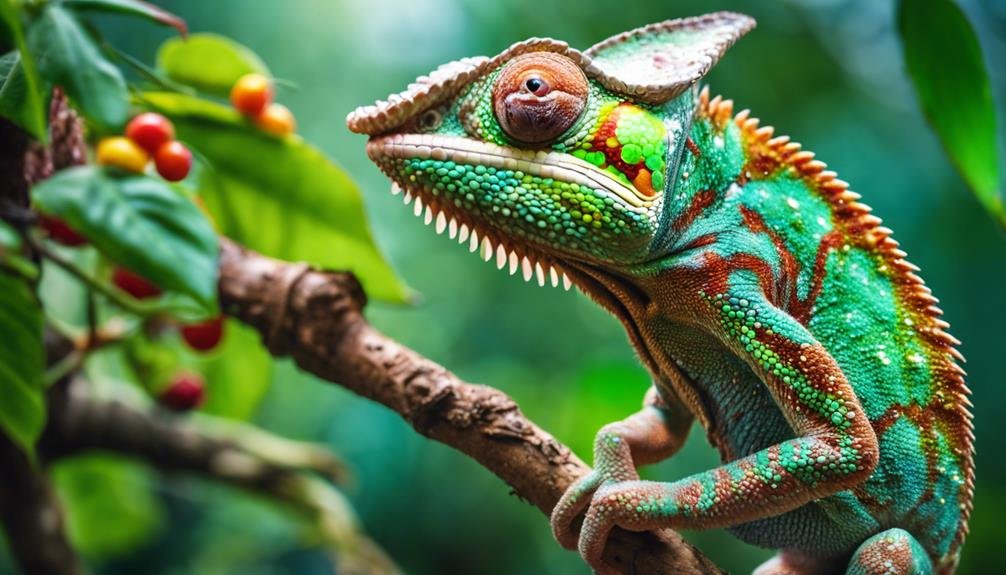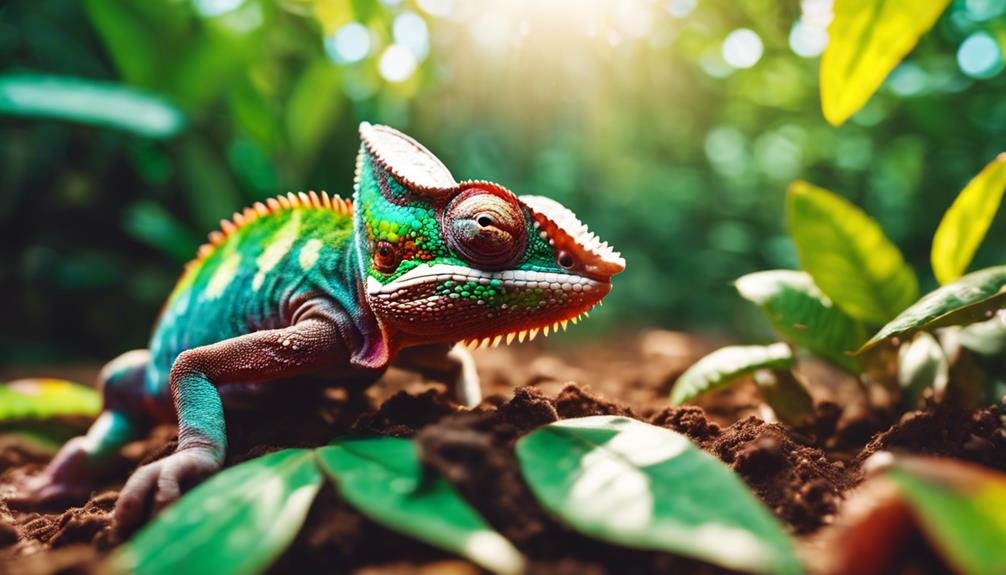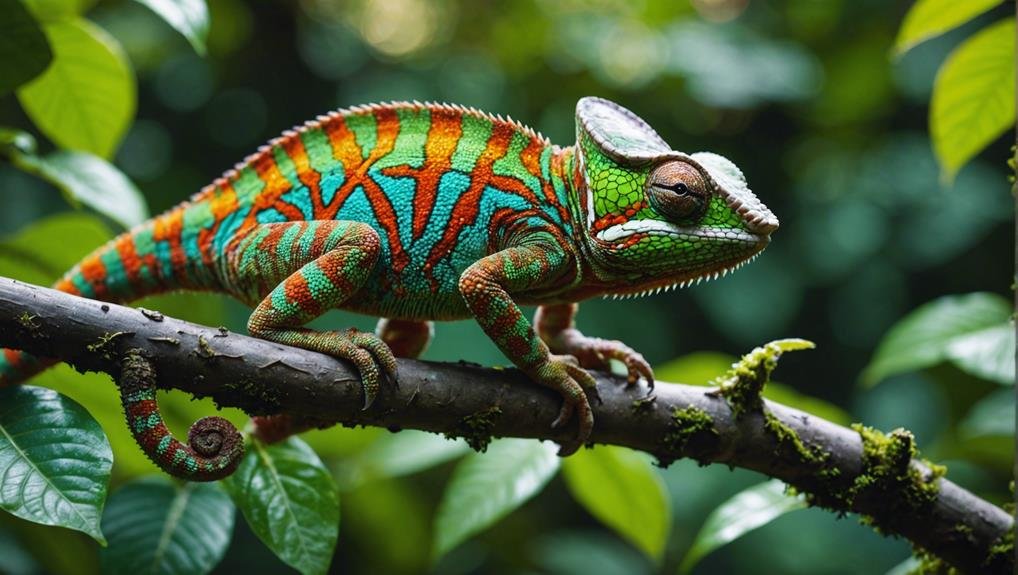When you think about chameleons, the first thing that likely comes to mind is their incredible ability to change color. This isn’t just for camouflage; they also shift hues based on their mood, light, temperature, and humidity. Nerve impulses control these changes and involve four distinct layers of skin. But have you ever wondered why males display such vibrant colors or how they spot prey from meters away with their unique eyesight? There’s more to these fascinating creatures than meets the eye. Let’s explore what makes chameleons remarkable and why they deserve our attention. Learn more about Chameleon Facts.
Key Takeaways
- Chameleons can change color based on mood, light, temperature, and humidity.
- They have 360-degree vision with independently moving eyes.
- Chameleons’ diet includes insects, foliage, and fruits, depending on the species.
- Madagascar hosts the most diverse chameleon population.
- Female chameleons lay eggs that take 4-24 months to hatch.
Unique Color-Changing Abilities


A complex interplay of mood, light, temperature, and humidity drives chameleons’ mesmerizing color-changing abilities. Unlike what many believe, chameleons don’t just change color for camouflage. Their skin’s color transformation involves four distinct layers and nerve impulses that help them communicate with others.
For instance, observing different chameleon species, you’ll notice that males often display brighter colors when trying to attract females. In contrast, females may change color during mating to signal acceptance or rejection.
Environmental factors, such as light and temperature, play a significant role in how these reptiles change color. When the temperature drops or rises, their skin adjusts accordingly. Mood swings also affect their hues; a stressed chameleon might darken its skin, while a content one might appear more vibrant.
Their eyes, capable of moving independently, help them assess their surroundings and respond appropriately. The tongue, another remarkable feature, doesn’t directly affect color but plays a role in their overall interaction with the environment. Chameleons communicate their reproductive state and readiness for mating through these visual cues.
Incredible Eyesight
Beyond their remarkable color-changing abilities, chameleons also boast incredible eyesight that sets them apart in the animal kingdom. Chameleons have good eyesight, allowing them to see in 360 degrees. Their eyes can move independently, offering a panoramic view of their surroundings. This unique feature enables them to focus their eyes relatively, judge distances, and spot prey accurately.
Chameleons can spot prey from 5 to 10 meters away, an essential skill for their survival. They can also see ultraviolet light, which is vital for their reproduction and overall health. This enhanced vision aids them as they traverse trunks and branches, ensuring they can navigate their environment effectively.
Here are some fascinating aspects of chameleon vision:
- Independent Eye Movement: Each eye can move separately, allowing chameleons to scan their environment thoroughly.
- Ultraviolet Vision: Seeing ultraviolet light helps in reproductive activities and maintaining good health.
- Distance Judging: Their ability to focus each eye independently helps them judge distances accurately when hunting or evading predators.
In addition to their sight, chameleons have highly adapted gripping abilities, and their tails can curl around branches in many different shapes, helping them traverse their arboreal habitats.
Even though chameleons can hear noises, their exceptional vision remains their most impressive sensory adaptation. a
Diverse Diet and Feeding Habits


Thanks to their diverse diet and unique feeding habits, chameleons stay healthy and thrive in their natural habitats. Primarily, chameleons eat insects like locusts, grasshoppers, and crickets, which form the bulk of their diet. These insects provide essential nutrients, ensuring that chameleons meet their nutritional requirements. Notably, larger species eat more, sometimes consuming up to 50 large crickets daily.
Chameleons are well-equipped for their insectivorous lifestyle. They’ve long, sticky tongues that can extend up to twice their body length. Combined with their lightning-fast movements, these tongues allow them to catch prey with remarkable efficiency. Seeing a chameleon’s tongue shoot out to snare an unsuspecting insect is an impressive sight.
But chameleons don’t solely rely on insects. Some species supplement their diet with foliage and fruits. This supplementation helps them achieve a balanced diet, improving their overall health. Ensuring proper supplementation is vital for chameleons, especially in captivity, where their feeding habits might need closer monitoring.
Habitat and Distribution
Chameleons are found mainly in regions across Africa, Asia, Europe, and Madagascar, each offering diverse habitats that cater to their unique needs. Madagascar stands out as a chameleon hotspot, home to over two-thirds of all species. This island’s unique habitats and rich biodiversity provide an ideal environment for these fascinating reptiles.
Chameleons thrive in various environments, from lush rainforests and arid deserts to mountainous areas and open savannas. Chameleon species have specific habitat preferences, with some preferring tree canopies while others are ground dwellers. This adaptability is key to their widespread distribution.
However, not all is well in the chameleon world. Habitat loss due to human activities poses a significant threat to their populations. Deforestation, urbanization, and agricultural expansion rapidly shrink their natural environments, putting many species at risk.
- Madagascar: A biodiversity hotspot with unique habitats critical for chameleon survival.
- Variety of Environments: Rainforests, deserts, mountains, and savannas support different chameleon species.
- Threats: Habitat loss due to human activities severely impacts chameleon populations.
Understanding the habitat and distribution of chameleons highlights the importance of conserving their environments to safeguard their continued survival.
Reproduction and Life Cycle


Understanding chameleons’ unique habitats is just one part of the story; their reproduction and life cycle reveal even more fascinating aspects of these remarkable reptiles.
Female chameleons lay eggs, with the number of eggs depending on the species—ranging from just 2 to as many as 200. These eggs can take anywhere from 4-12 months to hatch, though some species require an incubation period of up to 24 months. When they finally hatch, baby chameleons look like smaller versions of the adults and instinctively hunt insects.
Chameleons exhibit diverse reproductive strategies. While most species lay eggs, some give live birth, adding another layer of complexity to their life cycles.
In captivity, chameleons can live up to 10 years, provided they receive proper care and habitat. This includes maintaining the right temperature, humidity, and access to food.
Conservation Status and Threats
Chameleon populations have faced significant threats in recent years due to habitat loss and human activities. Many species are now endangered as forests, especially in Madagascar, are destroyed to make way for agriculture and urban development. This habitat loss severely impacts chameleons, disrupting their environments and food sources.
Human activities like the illegal pet trade also pose significant threats. Chameleons are often captured and sold, reducing wild populations and leading to potential extinction for some species. Responsible pet ownership is important if you’re considering a chameleon as a pet. Ensure your pet comes from a reputable source to avoid contributing to these problems.
Conservation efforts are essential to protect endangered chameleon species. Organizations are working hard to mitigate these threats and preserve habitats. By supporting these efforts, you can help chameleons thrive for future generations.
- Habitat destruction: Urban development and agriculture lead to the loss of essential environments.
- Illegal pet trade: Wild chameleons are captured and sold, reducing populations significantly.
- Conservation efforts: Supporting initiatives helps protect and restore chameleon habitats.
Conclusion
You’ve now explored the amazing world of chameleons. Their unique color-changing abilities, incredible eyesight, diverse diet, and fascinating reproductive habits make them remarkable creatures. Chameleons need our support to thrive in varied habitats and face numerous threats.
By understanding and appreciating their uniqueness, you can help conserve them. So, let’s work together to ensure that these extraordinary reptiles continue to enchant our world for generations to come.

